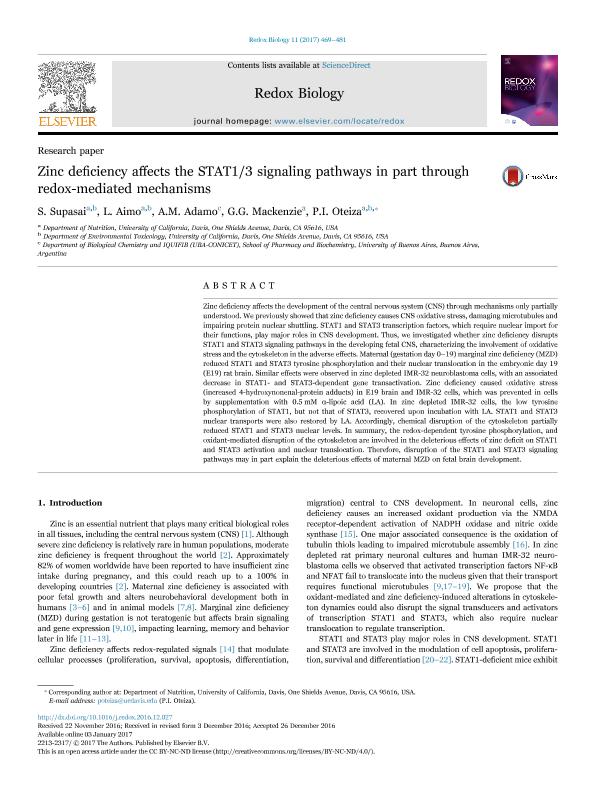Mostrar el registro sencillo del ítem
dc.contributor.author
Supasai, S.
dc.contributor.author
Aimo, L.
dc.contributor.author
Adamo, Ana María

dc.contributor.author
Mackenzie, Gerardo G.

dc.contributor.author
Oteiza, Patricia Isabel

dc.date.available
2018-06-04T17:51:59Z
dc.date.issued
2017-04
dc.identifier.citation
Supasai, S.; Aimo, L.; Adamo, Ana María; Mackenzie, Gerardo G.; Oteiza, Patricia Isabel; Zinc deficiency affects the STAT1/3 signaling pathways in part through redox-mediated mechanisms; Elsevier; Redox Biology; 11; 4-2017; 469-481
dc.identifier.issn
2213-2317
dc.identifier.uri
http://hdl.handle.net/11336/47171
dc.description.abstract
Zinc deficiency affects the development of the central nervous system (CNS) through mechanisms only partially understood. We previously showed that zinc deficiency causes CNS oxidative stress, damaging microtubules and impairing protein nuclear shuttling. STAT1 and STAT3 transcription factors, which require nuclear import for their functions, play major roles in CNS development. Thus, we investigated whether zinc deficiency disrupts STAT1 and STAT3 signaling pathways in the developing fetal CNS, characterizing the involvement of oxidative stress and the cytoskeleton in the adverse effects. Maternal (gestation day 0?19) marginal zinc deficiency (MZD) reduced STAT1 and STAT3 tyrosine phosphorylation and their nuclear translocation in the embryonic day 19(E19) rat brain. Similar effects were observed in zinc depleted IMR-32 neuroblastoma cells, with an associated decrease in STAT1- and STAT3-dependent gene transactivation. Zinc deficiency caused oxidative stress (increased 4-hydroxynonenal-protein adducts) in E19 brain and IMR-32 cells, which was prevented in cells by supplementation with 0.5 mM α-lipoic acid (LA). In zinc depleted IMR-32 cells, the low tyrosine phosphorylation of STAT1, but not that of STAT3, recovered upon incubation with LA. STAT1 and STAT3 nuclear transports were also restored by LA. Accordingly, chemical disruption of the cytoskeleton partially reduced STAT1 and STAT3 nuclear levels. In summary, the redox-dependent tyrosine phosphorylation, and oxidant-mediated disruption of the cytoskeleton are involved in the deleterious effects of zinc deficit on STAT1and STAT3 activation and nuclear translocation. Therefore, disruption of the STAT1 and STAT3 signaling pathways may in part explain the deleterious effects of maternal MZD on fetal brain development.
dc.format
application/pdf
dc.language.iso
eng
dc.publisher
Elsevier
dc.rights
info:eu-repo/semantics/openAccess
dc.rights.uri
https://creativecommons.org/licenses/by-nc-nd/2.5/ar/
dc.subject
Zinc Deficiency
dc.subject
Stat1/3
dc.subject
Oxidative Stress
dc.subject.classification
Otras Ciencias Biológicas

dc.subject.classification
Ciencias Biológicas

dc.subject.classification
CIENCIAS NATURALES Y EXACTAS

dc.title
Zinc deficiency affects the STAT1/3 signaling pathways in part through redox-mediated mechanisms
dc.type
info:eu-repo/semantics/article
dc.type
info:ar-repo/semantics/artículo
dc.type
info:eu-repo/semantics/publishedVersion
dc.date.updated
2018-06-04T17:00:52Z
dc.journal.volume
11
dc.journal.pagination
469-481
dc.journal.pais
Países Bajos

dc.journal.ciudad
Amsterdam
dc.description.fil
Fil: Supasai, S.. University of California at Davis; Estados Unidos
dc.description.fil
Fil: Aimo, L.. University of California at Davis; Estados Unidos
dc.description.fil
Fil: Adamo, Ana María. Consejo Nacional de Investigaciones Científicas y Técnicas. Oficina de Coordinación Administrativa Houssay. Instituto de Química y Físico-Química Biológicas "Prof. Alejandro C. Paladini". Universidad de Buenos Aires. Facultad de Farmacia y Bioquímica. Instituto de Química y Físico-Química Biológicas; Argentina
dc.description.fil
Fil: Mackenzie, Gerardo G.. University of California at Davis; Estados Unidos
dc.description.fil
Fil: Oteiza, Patricia Isabel. University of California at Davis; Estados Unidos
dc.journal.title
Redox Biology
dc.relation.alternativeid
info:eu-repo/semantics/altIdentifier/doi/https://dx.doi.org/10.1016/j.redox.2016.12.027
dc.relation.alternativeid
info:eu-repo/semantics/altIdentifier/url/https://www.sciencedirect.com/science/article/pii/S2213231716303536
Archivos asociados
